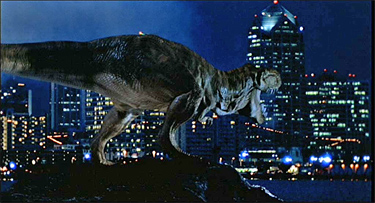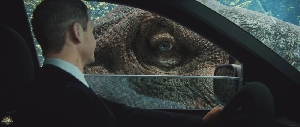The Arms of T-Rex, are they Really that Useless?
Dinosaurs Forum Topic

Lord of the Spinosaurs
MemberCompsognathusDec 8, 20146106 Views15 RepliesThe arms of T-Rex, Were they Really that Useless? The arms of T-Rex are often something that has been made fun of by people and even some Paleontologists, though is there really a reason to make fun of them? Just because they are small, does it really mean they were useless? Well lets find out.
Though we are also going to compare T-Rex to another large North American predator, Acrocanthosaurus. Throughout this Acrocanthosaurus not only will represent itself, it will pretty much represent all of the Carcharodontosaurs, which are Theropod that have relatively bigger arms than T-Rex. You see, this is sort of going to “Tyrannosaur arms Vs. Carcharodontosaur arms”, the winner and loser may surprise you. Anyways, lets get started.
Well before we look at the arms themselves, we have to look at the claws. First, we will look at a claw of Tyrannosaurus, here: ?
http://www.boneclones.com/images/ko-074-lg.jpg
The length of the claw itself is about the same as your thumb.
Anyways, if you notice the claw itself is not as sharp as other Theropod claws, it also appears to be shorter. This may seem like a disadvantage, though we will see later that this type of claw seems to be meant for something different.
Now we will look at the Acrocanthosaurus hand claw, so, here it is: ?
http://www.educationalbiofacts.com/images/CL01-Acrocanthosaurus-Hand-.jpg
The length of the claw itself is slightly longer than your thumb.
As you can see the claw itself is very long and sharp compared to the claw of the Tyrannosaurus. This is an illusion though, it makes it look bigger than it seems. The Tyrannosaurus claw is also wider than this one, the two claws would probably weigh about the same.
Now, as I said before, the claw of Tyrannosaurus is not as sharp as that of Acrocanthosaurus, though this is not exactly a disadvantage. You see, the claws of Tyarnnosaurus seem to be more fit for being lodged into prey and staying in there, this would be useful for gripping struggling prey, hence why it seems stronger (wider) and all though shorter than the Acrocanthosaurus claw, its just as curved. As for the Acrocanthosaurus claw, it seems sharper but not as strong (wide) as the Tyrannosaurus claw, which suggest that the claws of Acrocanthosaurus were meant to do damage to prey items, not to grip them.
Though what you are about to see next is even more amazing.
You see, the arms of Tyrannosaurus are not too flexible, in fact a study showed that Tyrannosaurus could only move its shoulder and elbow joints 45 degrees of motion, which is unimpressive considering that us, humans, can move our arms almost 360 degrees. ?
http://img1.wikia.nocookie.net/__cb20090124063918/landbeforetime/images/f/f7/T.rex_arm.jpg Though
Lets see how Tyrannosaurus compares to Acrocanthosaurus...
The flexibility of arms Acrocanthosaurus seems to not come to close to that of Tyrannosaurus. It seems that Acrocanthosaurus could only move its shoulder and elbow joints 25 degrees of motion. That seems almost sad compared to Tyrannosaurus. So it seems the arms of Tyrannosaurus may have been very flexible for a large Theropod Dinosaur. ?
http://www.angelfire.com/mi/dinosaurs/images/casts/acrocanthosaurus_arm_cast.jpg
Though if the arms of Acrocanthosaurus were not very flexible than what were they used for? Well, as we know, Acrocanthosaurus is actually one of of the only (if not the only) Theropod that we can confirm was a Sauropod hunter, which means that these arms would be pretty much useless for that. Perhaps having a low range of motion would protect Acro’s arms. Though its arms may have been used for taking out prey smaller than itself.
And back to the arm of T-Rex, it seems to have a lot of muscle attached to the base of the arm, this can be helpful for when prey tries to run away the arm does not go with it without the rest of the Rex (imagine that).
Now, I want you to do an experiment. Stand just in front of a wall, now first limit your arms to a 45 degree angle and try to sort of scratch the wall (don’t leave a dent!), you will probably be able to just barely scratch it. Now do the same thing but limit your arms to a 25 degree angle, it seems almost impossible to do it unless you are really hugging the wall, and even doing that you can’t do much.
So, lets imagine it, Tyrannosaurus vs Acrocanthosaurus (or really any large Carcharodontosaur), they can both only use there arms. Tyrannosaurus seems to be able to reach Acrocanthosaurus easily, though Acrocanthosaurus is having a lot of trouble, it can’t seem to be able to reach T-Rex unless it some how pushes the animal (let me also mention T-Rex is larger than it) onto the ground, and even if it does that it cannot deliver a fatal blow. Let me also point this out, the arms of Acrocanthosaurus are only SLIGHTLY larger than those of T-Rex, and Acrocanthosaurus had relatively the largest arms (if not the largest) of any Carcharodontosaur.
Now, before I end this off we are going to compare how strong a Tyrannosaurus Rex arm is compared to a Homo Sapien arm. You see, a study showed that a T-Rex can lift almost half a ton, which is amazing for human standards. No human weight lifter has lifted that much.
So in conclusion, it seems that T-Rex was the only large Theropod that could easily use its arms on any prey no matter the size, the arms of Acrocanthosaurus (and other Carcharodontosaurs) are useless for prey its size or bigger, meaning that they would be pretty much useless against another Acrocanthosaurus or Tyrannosaurus for that matter unless it was able to knock them over, in contrast to Tyrannosaurus.
There is no such thing as a pure predator. A meat-eater is eit
Replies to The Arms of T-Rex, are they Really that Useless?
Hey Guest, want to add your say?
Are you an avid Jurassic World fan looking for a dedicated online community of likeminded fans? Look no further! Create your own profile today and take part in our forums and gain XP points for all the content you post!


















